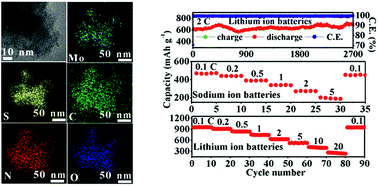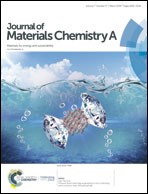Ultrathin MoS2 nanosheets homogenously embedded in a N,O-codoped carbon matrix for high-performance lithium and sodium storage†
Abstract
MoS2 nanosheets, which possess a high theoretical capacity, have drawn wide attention as an anode material for lithium ion batteries (LIBs) and sodium ion batteries (SIBs). However, MoS2 nanosheets suffer from poor cycling stability and rate performance caused by structural deterioration, large volume change upon cycling, poor conductivity, and aggregation of nanosheets. Here, a MoS2/C nanocomposite with ultrathin MoS2 nanosheets homogenously embedded in a N,O-codoped carbon matrix is obtained under high pressure by pyrolysis of a solution of ammonium tetrathiomolybdate dissolved in dimethylformamide in a sealed vessel. The MoS2/C nanocomposite possesses a unique structure with an expanded interlayer spacing of 10.5 Å for the MoS2 nanosheets and formation of Mo–O–C and Mo–N–C bonds at the interface between the MoS2 nanosheets and carbon matrix. The expansion of the interlayer spacing for the MoS2 nanosheets may result from insertion of single-layer carbon atoms in between MoS2 layers. The unique structure is beneficial for solving the above-mentioned problems and thus obtaining superior lithium and sodium storage performances. As an anode for LIBs, MoS2/C delivers excellent cyclability (capacity retention of 115.4% after 2700 cycles) and superior rate capability (234.7 mA h g−1 at 20C). As an anode for SIBs, MoS2/C exhibits excellent cycling performance (capacity retention of 91.5% after 100 cycles) and outstanding rate performance (187.9 mA h g−1 at 5C).



 Please wait while we load your content...
Please wait while we load your content...